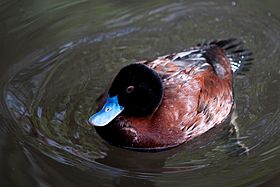Benger Swamp facts for kids
Quick facts for kids Benger Swamp |
|
|---|---|

The swamp supports globally important numbers of the blue-billed duck
|
|
| Location | Swan Coastal Plain, Western Australia |
| Coordinates | 33°10′15″S 115°50′10″E / 33.17083°S 115.83611°E |
| Type | Swamp |
| Primary outflows | Groundwater; evaporation |
| Basin countries | Australia |
| Designation | Benger Swamp Nature Reserve |
| Max. length | 2.8 km (1.7 mi) |
| Max. width | 1.75 km (1.09 mi) |
| Surface area | 580 hectares (1,433 acres) |
| Max. depth | 0.8 m (2 ft 7 in) |
| Surface elevation | 15 m (49 ft) |
Benger Swamp is a special wetland in south-west Western Australia. It's a place where the land is often wet, like a marsh or bog.
This swamp is about 2 kilometres (1.2 mi) west of Benger and 155 kilometres (96 mi) south of Perth. Most of the swamp (89%) is a protected area called Benger Swamp Nature Reserve. The rest is owned by private people.
Benger Swamp is very important for waterbirds during certain seasons. BirdLife International has even called it an Important Bird Area. This is especially true for freckled ducks and Australasian bitterns. People manage the water levels in the swamp. This helps both the birds and nearby farming activities.
Contents
Discover Benger Swamp: A Unique Wetland Area
Benger Swamp sits in a low area on the Pinjarra Plain. This plain is part of the larger Swan Coastal Plain. The soil here is soft and dark grey, mostly loam (a mix of sand, silt, and clay) over clay.
To the west, there are small hills. These were formed by wind blowing away the dry swamp surface in summer. The water in the swamp is fresh. It floats on top of salty water underground.
Plants of Benger Swamp: What Grows Here?
About 20% of Benger Swamp is covered by Melaleuca trees and bushes. These are mostly found along the northern and eastern edges. There are four types of Melaleuca here:
- Melaleuca rhaphiophylla (swamp paperbark) grows as a thick, low forest, up to 10 metres (33 ft) tall.
- Melaleuca viminea, M. laterita, and M. scabra are smaller bushes.
Half of the swamp is covered by an introduced plant called bulrush (Typha orientalis). Another plant, Baumea articulata (jointed rush), covers about 1% of the swamp. In areas that are often flooded, you'll find couch grass (Cynodon dactylon) and water couch (Paspalum distichum).
Animals of Benger Swamp: Who Lives Here?
Benger Swamp is a busy place for many animals, especially birds!
Amazing Birds of the Swamp
Besides the freckled ducks and Australasian bitterns, many other wetland birds call this swamp home. These include:
- Pacific and white-faced herons
- White and straw-necked ibis
- Swamp harrier
- Purple swamphen
- Hardhead
- Spotless crake
- Wood sandpiper
- Australian reed-warbler
- Little grassbird
- Blue-billed duck
Other Wildlife You Might See
You might also spot native mammals like western grey kangaroos and rakali (also known as water rats). Tiger snakes are common here too. Unfortunately, some introduced animals like foxes, cats, and rodents also live in the swamp.
Challenges for Benger Swamp: What Are the Threats?
One big problem for Benger Swamp is the Typha plants. They dry out during the hot, dry summers in the region. When they dry out, they can easily catch fire. These bushfires can destroy the Melaleuca trees. The Melaleuca trees are very important because they provide a safe place for freckled ducks to moult (shed their feathers) and raise their young.


